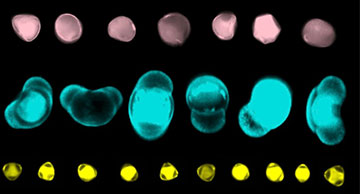
Researchers have developed a system that combines imaging and artificial intelligence to capture bright-field, side-scatter and autofluorescence images of pollen grains and classify the tiny particles. [Image: University of Exeter]
Counting and classifying tiny pollen grains under an ordinary light microscope is tedious work. Now researchers have brought optical technology and artificial intelligence (AI) together to speed up the task (New Phytologist, doi: 10.1111/nph.19186).
Through a process called imaging flow cytometry, the team captured bright-field, side-scatter and autofluorescence images of 5,500-year-old fossil pollen specimens. Computational neural networks guided deep learning to categorize the ancient grains based on standard training libraries of previously identified pollen images.
Besides exploring the preserved pollen found at archaeological sites, the technique could improve future atmospheric pollen readings to warn allergy sufferers about outdoor conditions, the researchers say.
Imaging flow cytometry
In basic flow cytometry, particles suspended in a fluid pass through a nozzle into a narrow tube. A laser, positioned perpendicular to the tube, illuminates the tiny objects whizzing single file through the beam, and various mirrors and detectors pick up the resulting signals. In some cases, flow cytometry simply counts and separates cells or other particles, but with microscopic imaging technology, the method can acquire tens of thousands of pictures per second.
When the researchers trained the network on the images of the fossil pollen grains, the AI tool categorized 100% of the ancient particles at the order level, 77% at the family level and 96% at the genus level.
The team—led by Claire M. Barnes, Swansea University, UK, and Ann L. Power, University of Exeter, UK—extracted ancient pollen from lake sediment cores and, as a reference sample, assembled a collection of pollen grains from 53 modern plant species. The researchers employed a commercially available imaging flow cytometry device with both bright-field illumination and five excitation lasers ranging in wavelength from 405 to 785 nm. Six detection channels collected autofluorescence, bright-field and side-scatter images of the ancient and modern pollen at 20× magnification and 1 μm2 pixel resolution.
Next, the team trained a computational network to recognize the modern-pollen reference library down to the species level, resulting in the network successfully identifying pollen with 93% accuracy. When the researchers trained the network on the images of the fossil pollen grains, the AI tool categorized 100% of the ancient particles at the order level, 77% at the family level and 96% at the genus level—which is one level up from species in biological taxonomy.
Pollen forecast
“Incorporating a unique version of deep learning into our system means the artificial intelligence is smarter and applies a more flexible approach to learning,” Barnes said in a press release accompanying the paper. “It can deal with poor-quality images and can use shared species characteristics to predict what family of plant the pollen belongs to even if the system hasn’t seen it before during training.”
In the coming years, the researchers hope to refine and launch their system and to use it to learn more about grass pollen—a particular irritant for people who suffer from hay fever, also known as seasonal allergies. “Some grass pollens are more allergenic than others,” Power said. “If we can understand better which pollens are prevalent at specific times, it would lead to improvements in the pollen forecast that could help people with hay fever plan to reduce their exposure.”
